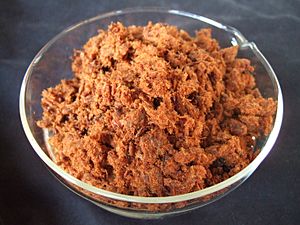Meat floss facts for kids

Meat floss made of beef
|
|
| Alternative names | Meat wool, pork floss, flossy pork, or pork sung |
|---|---|
| Place of origin | China |
| Region or state | East Asia and Southeast Asia |
| Associated national cuisine | China, Vietnam, Taiwan, Singapore, Malaysia, Cambodia and Indonesia |
| Main ingredients | Pork, beef, or chicken |
| Meat floss | |||||||||||||||||||
|---|---|---|---|---|---|---|---|---|---|---|---|---|---|---|---|---|---|---|---|
| Chinese name | |||||||||||||||||||
| Traditional Chinese | 肉鬆 | ||||||||||||||||||
| Simplified Chinese | 肉松 | ||||||||||||||||||
| Literal meaning | meat fluff | ||||||||||||||||||
|
|||||||||||||||||||
| Southern Min name | |||||||||||||||||||
| Chinese | 肉酥 | ||||||||||||||||||
| Literal meaning | meat flakes | ||||||||||||||||||
|
|||||||||||||||||||
| Eastern Min name | |||||||||||||||||||
| Traditional Chinese | 肉絨 | ||||||||||||||||||
| Simplified Chinese | 肉绒 | ||||||||||||||||||
| Literal meaning | meat fabric | ||||||||||||||||||
|
|||||||||||||||||||
| Hakka name | |||||||||||||||||||
| Chinese | 肉麩 | ||||||||||||||||||
| Literal meaning | meat powder; meat fabric | ||||||||||||||||||
|
|||||||||||||||||||
| Vietnamese name | |||||||||||||||||||
| Vietnamese | ruốc (Northern Vietnamese) or chà bông (Southern Vietnamese) | ||||||||||||||||||
| Thai name | |||||||||||||||||||
| Thai | หมูหย็อง | ||||||||||||||||||
| RTGS | mu yong | ||||||||||||||||||
| Indonesian name | |||||||||||||||||||
| Indonesian | abon | ||||||||||||||||||
| Filipino name | |||||||||||||||||||
| Tagalog | mahu or masang | ||||||||||||||||||
| Khmer name | |||||||||||||||||||
| Khmer | សាច់ជ្រូកផាត់ sach chruok phat | ||||||||||||||||||
Meat floss is a unique dried meat product. It feels light and fluffy, almost like cotton. It first came from China.
It's also known by other names like rousong, yuk sung, or bak hu. You can find it in many parts of East Asia and Southeast Asia.
Contents
What is Meat Floss Used For?
Meat floss is a popular topping for many foods. It adds both flavor and a nice look.
You might see it sprinkled on congee (a type of rice porridge) or tofu. It's also great on rice and savory soy milk.
Meat floss is often used as a filling inside savory buns and pastries. Sometimes, it tops baked goods that have bean paste inside. You can even eat it by itself as a snack!
It's a very common food in Chinese, Vietnamese, and Indonesian meals. In Vietnam, it's called ruốc in the north and chà bông in the south.
How is Meat Floss Made?
Making meat floss involves a special cooking process. It usually starts with pork, chicken, or beef. Other meats can be used too.
First, the meat is cut into small pieces. Then, it's cooked slowly in a sweet mixture. This mixture includes soy sauce and different spices.
The meat cooks until its tiny muscle fibers can be easily pulled apart. This happens because a part of the meat called collagen turns into gelatine. Collagen usually holds the muscle fibers together.
After cooking, the meat is pulled apart and dried a little in an oven. Then, it's mashed and beaten while cooking in a large wok. This continues until the meat is almost completely dry. More flavors are often added during this frying step.
Different Styles of Meat Floss
There are two main ways to make meat floss, which affects its texture.
- The Jiangsu style rousong is cooked dry. This makes the final product a bit chewy.
- The Fujian style bak hu is fried with oil. This gives it a slightly crispy texture.
About Five kilograms (11 lb) of raw meat usually makes about one kilogram (2 lb) of meat floss.
Other Types of Floss
There are some products very similar to meat floss.
- Pork fu is like meat floss but less fried and not as shredded. It has a more stringy texture.
- Fish floss (yú sōng) is made from fish. It doesn't need to be stewed first. This is because fish meat has less collagen.
- You can also find floss made from rabbit and duck in China.
In Japan, a fish-based floss is called dembu (Japanese: 田麩).
In Indonesia and Malaysia, where many people are Muslim, beef or chicken floss is very popular. It's called abon in Indonesian and serunding in Malay. In Malaysia, serunding is a special treat during Ramadan and Eid al-Fitr.
In Northern Nigeria, the Hausa make a shredded beef snack called dambu nama. It's similar to meat floss, but it's fried and has a lot of spices.
Images for kids
-
Beef floss for sale in Sulawesi, Indonesia
-
Meat floss buns from Hong Kong
See Also
 In Spanish: Rousong para niños
In Spanish: Rousong para niños




